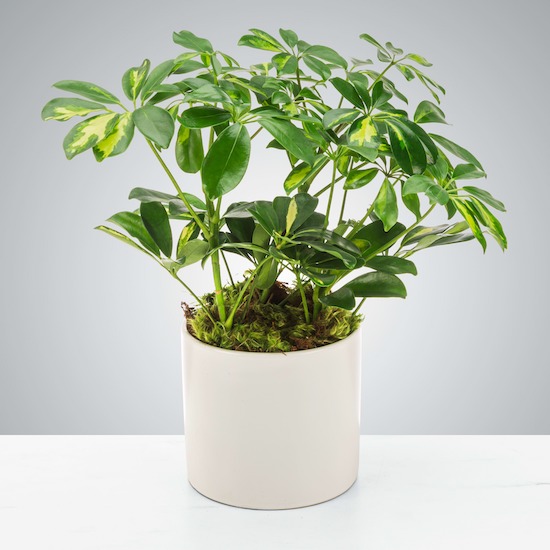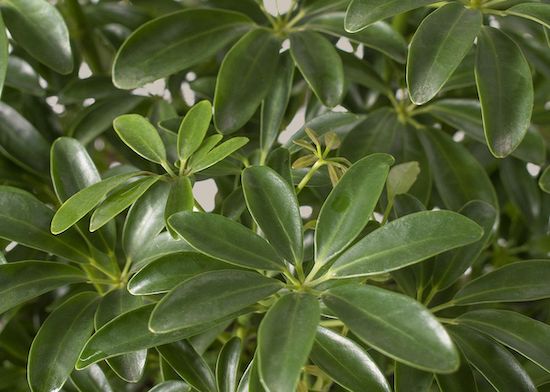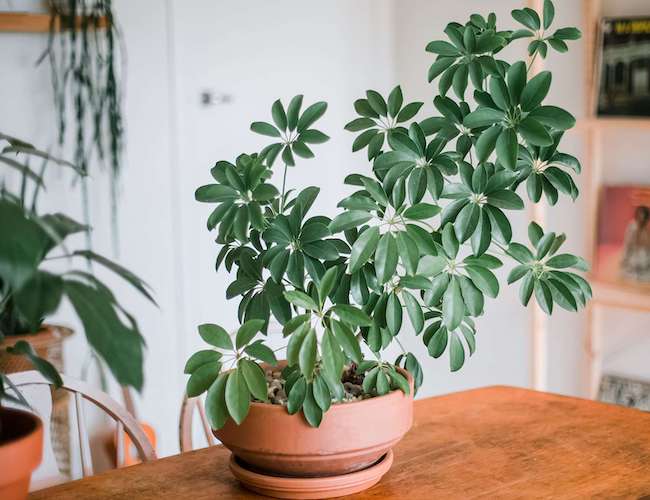How to Grow and Care for Umbrella Plant
Schefflera is a low-maintenance houseplant that comes in a variety of colors and sizes. The plant thrives in indirect light with well-draining soil and temperatures warmer than 60°F. We’ve prepared a guide covering all the aspects of growth and care for the Umbrella plant including its propagation, care tips, its types, and some FAQs.
How to Propagate Schefflera
So, the first question is, “How do you propagate Schefflera?” It’s quite simple. You can propagate Schefflera from stem cuttings.
To do this, just cut a stem with several nodes and dip the cut end in rooting hormone. Following that, insert the cutting in a 4-inch container filled with tropical potting mix.
Water it and keep it moist until you see a new growth. After a while, you’ll see a new plant develop, and that’s when you’re ready.
To learn more about propagation in detail, check out our article: Propagate Fiddle-Leaf Figs in Water or Soil
Schefflera (Umbrella Plant) Care Tips

Schefflera are low-maintenance indoor plants. So, there aren’t many things you have to look out for while caring for them. However, every plant needs some sort of care. Here are some things to keep in my mind for these plants:
- The plant thrives in indirect, bright light.
- Warm temperatures above 60°F.
- Prefers rich, well-draining, acidic soil.
- Give water when the soil dries but make sure you don’t overwater.
- An average indoor humidity of around 30% is fine but thrives at around 40%.
- Pests aren’t a major concern for these plants but if they do prove to be one, minor insecticides will be enough.
Light
Schefflera prefers bright and indirect light. Avoid placing the plant in direct, full sunlight as it can burn the leaves. During summertime, make sure you move them outside where they will receive bright light but not direct sun.
Soil
When growing indoors, plant it in a rich, well-drained, loose, potting soil. On the other hand, for outdoors, the ideal soil type is well-draining, and sandy with a slightly acidic pH.
Water
During the growing season, make sure you water it regularly and spray the leaves with water frequently. Don’t water if the soil is moist and cut back during winter.
Environment
As a tropical plant, Schefflera thrives in high humidity and temperatures. These plants don’t like being in temperatures lower than 60°F. Cold Schefflera will drop leaves quickly. Humidity is preferred to be over 40% but as mentioned previously, 30% is okay.
Fertilizer
Fertilize the plants twice a week during the growing season Since they are heavy feeders, they like the extra nutrients.
Types of Schefflera

The Schefflera genus has about 600 species. Of these 600, the most common houseplants are these two:
- Schefflera actinophylla: It is the one we generally remember when we talk about scheffleras. They have oval leaves that grow up to ten inches. A mature one has around 12 to 16 leaflets from a single stalk and can grow 15 feet indoors.
- Arboricola: This is the smaller version and is popular in home gardens. These plants have around 1- to 2-inch leaves that grow in tight clusters. Indoors, they grow around six feet.
Frequently Asked Questions
What is the expected lifespan of Schefflera?
Indoor, these plants can live for 25 years or longer.
Does the Schaeffer grow flowers?
It does in the wild but homegrown ones rarely do.
Can schleffera plants be left outside?
Yes, you leave them outside in the warm months as long as the temperatures are above 60°F and the plant is not placed in direct sunlight. How do you know if you have overwatered schefflera?
It’s simple – yellow leaves. The yellow leaves start falling pretty fast. In case of a root rot caused from overwatering, there will be brown spots on leaves and stems.
Which plants are similar to schefflera?
Money tree (Pachira aquatica) looks similar to schefflera.
